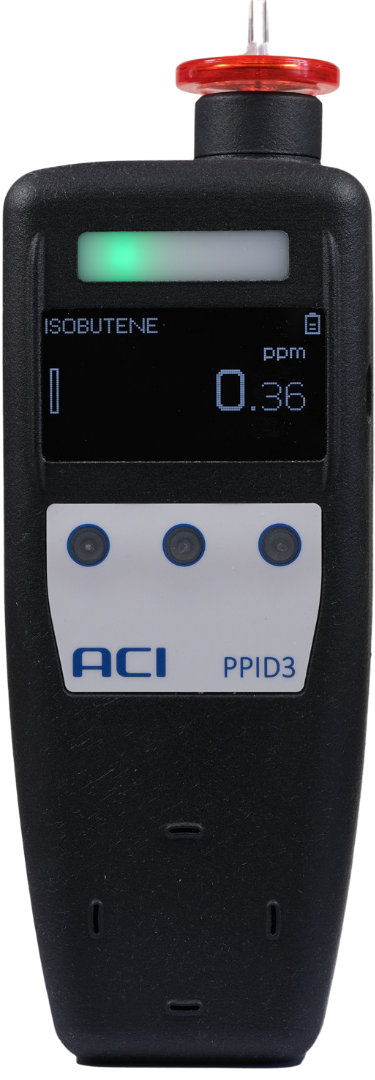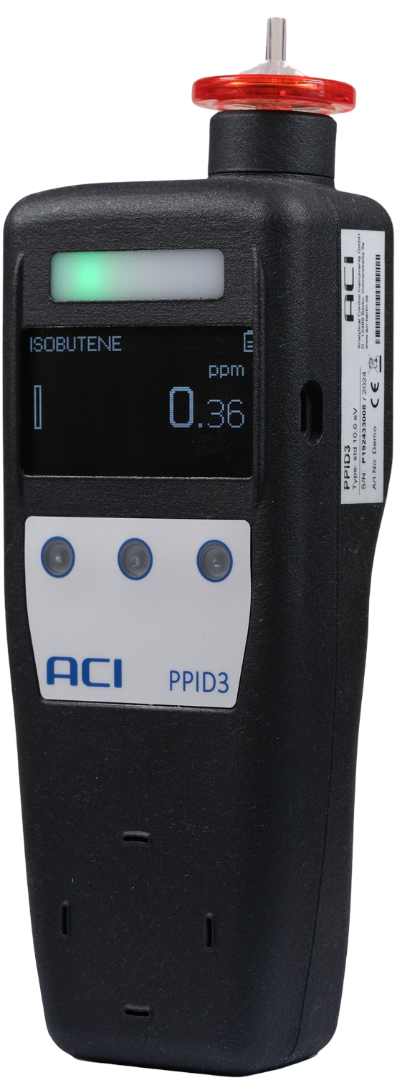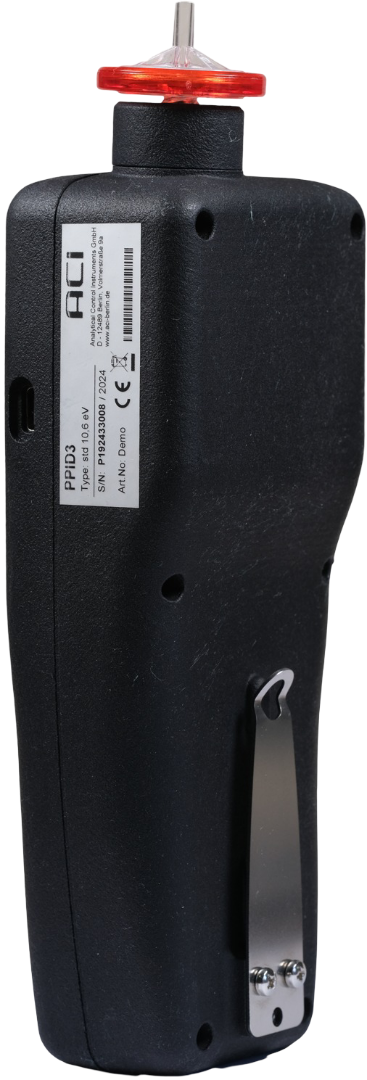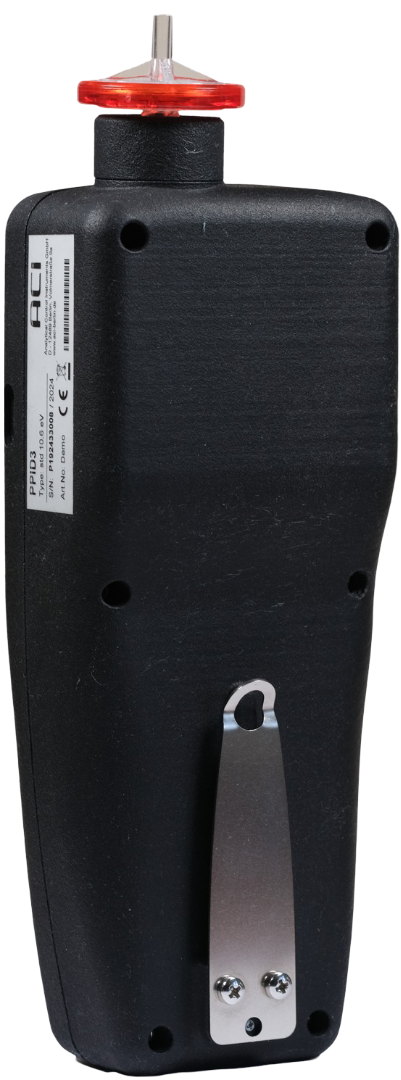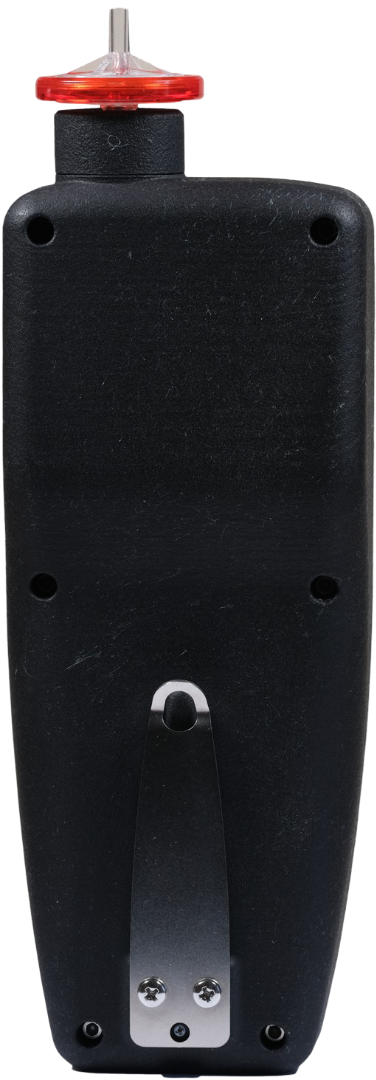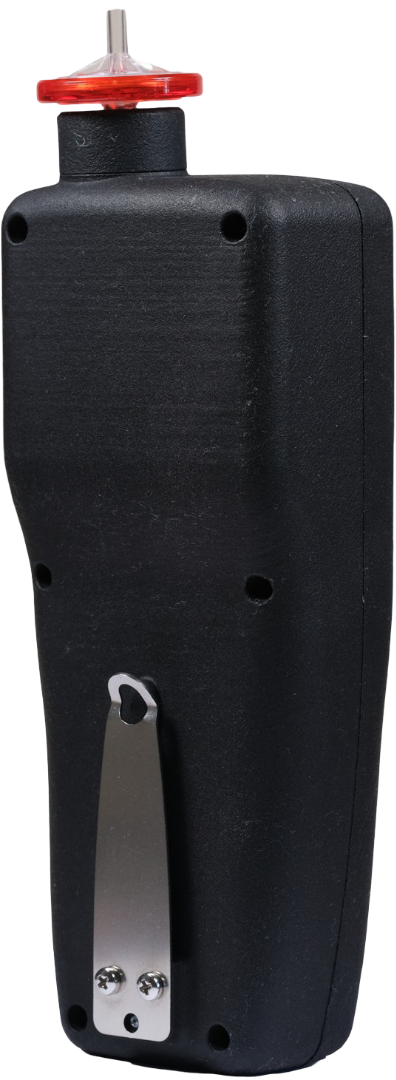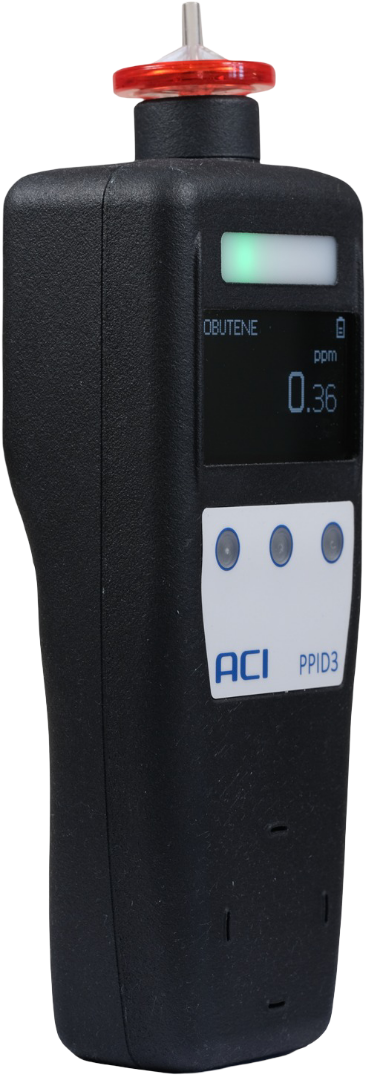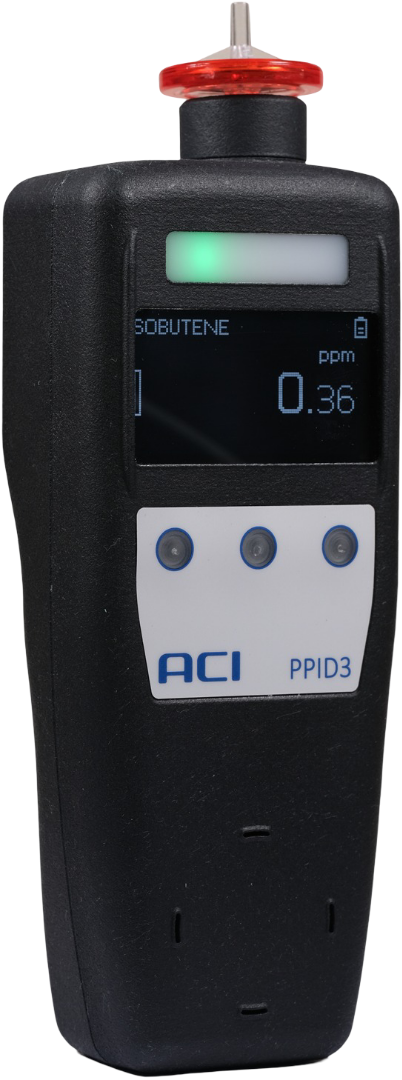The new generation of portable photoionization measuring devices.
|
|
The Portable PID handheld is a new generation of portable photoionization detectors for the detection of volatile organic compounds (VOCs) with an ionization potential < 10.6 eV, which presents the measurement properties known from the PPM in a completely revised, modern concept. The ultra-modern PID technology, combined with the experience of 20 years of measuring device construction, offers the professional user a measuring device with maximum sensitivity and robustness. Designed for field use, the Portable PID is suitable for both personal and stationary measuring tasks where hazardous substance concentrations (gases, vapours) in the air (working environment, indoor, soil gas, environment) need to be monitored. Equipped with a long-life VUV hollow cathode lamp (10.6 eV), the Portable PID covers a large measuring range of 0 - 2,000 ppm (ISOBUTEN equivalent). The Portable PID meets all the requirements of a modern, low-maintenance and user-friendly photoionization measuring system. |
Product Specification
Extended measuring rangeA new sensor unit allows an extended measuring range of up to 2 000 ppm (isobutene) with high resolution even at low concentrations. |
Easy user interfaceThe high-contrast, graphical 3.5-inch colour TFT display with intuitive user guidance, clear text instructions and step-by-step configuration supports the ease of use even in bad lighting. |
High performance PID lampThe ionization source is a high stable hollow cathode lamp with an energy of 10.6 eV. With its ceramic discharge channel, the stability is improved and a longer service life of up to 15 000 hours and more will achieved. |
Acoustic and visual warning functionsThe Portable PID has an acoustic alarm and two ultrabright LEDs that warn when adjustable concentration values are exceeded. |
Temperature / humidity compensationThe integrated humidity / temperature sensor measures in addition to the sensor signal the physical environment data and compensates their influence on the measuring result. |
Large data memoryThe data memory permits storage of more than 60 000 data records. Additionally, a separate storage is available for manually saved measuring data. A free PC software enables evaluation and logging of the saved data. |
Response factorsResponse factors for more than 250 gases are stored in the device. Additionally, the user can expand them by up to 20 customer-specific response factors. |
Diverse charging optionsThe Portable PID is equipped with a standard USB connection and can be charged with any common USB wall adapter or car charger. |
Easy calibrationThe Portable PID is calibrated with 100 ppm Isobuten at delivery. Calibration can be adjusted or repeated when required. |
Technical Data
|
|||||||||||||||||||||||||||||||||||||||||||||||||||||
Stationary detector for VOCs
|
|
The Stationary Photoionisation Detector SPID3 is a continuously measuring detector for volatile organic compounds (VOCs) with an ionisation potential < 10.6 eV. The use of new technologies for the light source and the sensor enables a high stability of the measurement and longer maintenance intervals. Automatic purging and automatic calibration are controlled via an integrated activated carbon filter and the sampling circuit. The device is designed for operation in potentially explosive atmospheres. |
Product Specification
Extended measuring rangeNewA new sensor unit allows three staggered measuring ranges from 20 ppm up to 5 000 ppm (isobutene) with high resolution at low concentrations. |
Easy user interfaceA graphic display with intuitive user guidance, clear text instructions and step-by-step configuration support the ease of use. |
High performance PID lampThe ionisation source is a hollow cathode lamp with an energy of 10.6 eV. The Ceramic Discharge Channel ensures high stability and a longer lifetime of up to 15 000 hours and more. |
Extended service intervalThe high stability of the lamp and the special design of the sensor in conjunction with automatic feeding of pollutant-free air through an activated carbon filter results in longer maintenance intervals. |
Simple calibrationEven in heavy environment, only one calibration gas is required for the simple menu driven two-point calibration. The applied active carbon filter provides the zero point. |
Automatic fresh air setupFor testing and adjusting the zero-point, pollutant-free air is applied via the activated carbon filter periodically through the gas path. |
Flexible connectionsA wide range of supply voltage, a configurable current loop output, alarm and error relays, a RS485 interface with MODBUS and HART protocol facilitate integration into your system. |
Temperature / humidity compensationThe integrated humidity / temperature sensor measures the physical environment data in addition to the sensor signal and compensates their influence on the measuring result. |
IECEx / ATEX certificationThe SPID3 fulfils the requirements for use in potentially explosive atmospheres and has the appropriate certifications in accordance with ATEX and IECEx. |
Technical Data
|
|||||||||||||||||||||||||||||||||||||||||||||||||||||
Smart Photoionization Detector Module PIDS3
|
|
The Smart Photoionization Module PIDS3 is an OEM module to detect volatile organic compounds with an ionization potential < 10.6eV. With its built-in electronics and microcontroller as well as a combined humidity/temperature sensor, it provides a flexible and easy to use adaptation into your measurement system. The module comes with a built-in linearization and temperature/humidity compensation. Built-in barometric pressure sensors offer later compensation and gas flow monitoring. The RS485 interface allows additional flexibility to choose the right interface for industrial and laboratory applications. The optional analogue 4 … 20 mA output represents the linearized and compensated concentration value in different scaling. The module is available in different measurement ranges, with optional included pump and 4 … 20 mA output and MODBUS. |
Product Specification
New
|
High performance PID lampThe ionization source is a high stable hollow cathode lamp with an energy of 10.6 eV. With its ceramic discharge channel, the stability is improved and a longer service life of up to 15 000 hours and more will achieved. |
Wide power supply rangeSince the power supply of the PID lamp is integrated, the unit works with a wide input range power supply. |
Flexible connectionsThe galvanic isolated RS485 interface supports reading measurement, diagnostic results, remote calibration and configuration. The RS485 interface allows additional flexibility to choose the right interface for industrial and laboratory applications. The optional analog 4 .. 20 mA output represents the linearized and compensated concentration value in different scaling.
|
Temperature / humidity compensationThe integrated humidity / temperature sensor measures in addition to the sensor signal the physical environment data and compensates their influence on the measuring result. |
Barometric pressureOne integrated barometric pressure sensor measures continuously at the gas inlet of the measurement chamber. |
Signal processingA microcontroller handles the measurement and control functions, performs all calculations and provides the result. There is no knowledge of the particular operation of the PID sensors required. |
Gas flow monitoringThe integrated pressure sensors measures continuously the pressure drop over the measurement chamber do ensure proper flow. (a version with integrated pump is available) |
Technical Data
|
|||||||||||||||||||||||||||||||||||||||||||||
Stationary Detector for VOCs
|
|
The Stationary Photoionization Detector SPID3 is a continuously measuring detector for volatile organic compounds (VOCs) with an ionization potential < 10.6 eV. The use of new technologies for the light source and the sensor enables a high stability of the measurement and longer maintenance intervals. Automatic purging and automatic calibration are controlled via an integrated activated carbon filter and the sampling circuit. The device is designed for operation in potentially explosive atmospheres. The SPID2 uses a high stable hollow cathode lamp with an energy of 10.6 eV as ionization source. This lamp provides with its ceramic discharge channel a highly stable UV output and a lifetime of 8,000 h (typically 15,000 hours and more). The special design of the sensor in conjunction with automatic feeding of pollutant-free air through an activated carbon filter results in longer maintenance intervals. The detector provides an analog (4-20 mA) output to represent the linearized and compensated measurement result in different scaling and digital (RS485-MODBUS) output which supports reading measurements and diagnostic results. The SPID2 is equipped with a graphical back-lighted display and high brightness Led’s for normal operations, failures and alarm conditions. The intuitive graphical menu guide and a non – intrusive magnetic key interface make it easy to use. |
Produktspezifikationen
Extended measuring rangeA new sensor unit allows three staggered measuring ranges from 20 ppm up to 2 000 ppm (isobutene) with high resolution at low concentrations. |
Easy user interfaceA graphic display with intuitive user guidance, clear text instructions and step-by-step configuration support the ease of use. |
High performance PID lampThe ionisation source is a hollow cathode lamp with an energy of 10.6 eV. The Ceramic Discharge Channel ensures high stability and a longer lifetime of up to 15 000 hours and more. |
Extended service intervalThe high stability of the lamp and the special design of the sensor in conjunction with automatic feeding of pollutant-free air through an activated carbon filter results in longer maintenance intervals. |
Simple calibrationEven in heavy environment, only one calibration gas is required for the simple menu driven two-point calibration. The applied active carbon filter provides the zero point. |
Automatic fresh air setupFor testing and adjusting the zero-point, pollutant-free air is applied via the activated carbon filter periodically through the gas path. |
Flexible connectionsA wide range of supply voltage, a configurable current loop output, alarm and error relays, a RS485 interface with MODBUS facilitate integration into your system. |
Temperature / humidity compensationThe integrated humidity / temperature sensor measures the physical environment data in addition to the sensor signal and compensates their influence on the measuring result. |
IECEx / ATEX certificationThe SPID2 fulfils the requirements for use in potentially explosive atmospheres and has the appropriate certifications in accordance with ATEX and IECEx. |
Technical Data
|
|||||||||||||||||||||||||||||||||||||||||||||||||||||
Portable PhotoIonization Detector for VOCs
|
|
The Portable Photoionization Detector PPID3 is a detector for volatile organic compounds (VOCs) with an ionisation potential < 10.6 eV. The use of new technologies for the light source and the sensor enables a high stability of the measurement and longer maintenance intervals. |
Product Specification
Extended measuring rangeNewA new sensor unit allows three staggered measuring ranges up to 2 000 ppm (isobutene) with high resolution at low concentrations. |
Easy user interfaceA graphic display with intuitive user guidance, clear text instructions and step-by-step configuration support the ease of use. |
High performance PID lampThe ionisation source is a hollow cathode lamp with an energy of 10.6 eV. The Ceramic Discharge Channel ensures high stability and a longer lifetime of up to 15 000 hours and more. |
Acoustic and visual warning functionsThe Portable PID has an acoustic alarm and two ultrabright LEDs that warn when adjustable concentration values are exceeded. |
Simple calibrationOnly one calibration gas is required for the simple menu driven two-point calibration. |
Diverse charging optionsThe Portable PID is equipped with a standard USB-C connection and can be charged with any common USB-C wall adapter or car charger and has the option for wireless charging. |
Temperature / humidity compensationThe integrated humidity / temperature sensor measures the physical environment data in addition to the sensor signal and compensates their influence on the measuring result. |
Technical Data
| Detector principle |
VUV-Photoionization with 10.6 eV hollow cathode lamp |
| Detection ranges | 0 … 2000 ppm Isobutene * |
| Display range | 0 … 20 000 ppm, depending on response factor of detected substance |
| Lower detection limit | Typical 0.05 ppm * |
| Display resolution | Dynamic |
| Response time | T90 < 10 s * |
| Signal integrity | up to 100 ppm typical > 98 % * up to 2 000 ppm typical > 95 % * |
| Influence of humidity and temperature |
Humidity and temperature compensation at 0 ... 50 °C and 0 … 90 % rH |
| Operating conditions | -10 … 50 °C 0 … 95 % rH, non-condensing |
| Storage conditions | -20 … 60 °C 0 … 95 % rH, non-condensing (45°C for 3 month limited by battery) |
| Gas sampling | Integrated diaphragm pump (about 200-300 ml/min) with function monitor, Sample inlet with dust and water protection filter |
| PID lamp lifetime | 10.6 eV: Min. 8 000 h, typical more than 15 000 h |
| Alarms | Locked alarm, self-triggering alarm, 2 adjustable alarm levels |
| Power supply | Integrated lithium-ion battery 3,6 V/24 Wh |
| Signalisation | Visual: Ultra-bright LEDs, Acoustic: Alarm, at least 90 dB (A) in 30 cm |
| Runtime Charging time |
Runtime >15 hours Charge approx. 6 hours with USB-C charger (5V / 15W), approx. 10 hours with Wireless-Charger |
| Display | Full graphic monochrome OLED-display |
| Digital interface | USB-C |
| Calibration | Two-point calibration zero gas and span gas via sample inlet |
| Response factors |
about 100 selectable response factors can be set |
| Memory | For 8 hours one measurement data per second including time, temperature, and humidity |
| Program functions | Continuous measurement with automatic and manual data storage, threshold monitoring, two-point calibration, self-test, fresh air compensation |
| Dimension, weight | 220 mm x 75 mm x 48 mm (L x W x H), less 450 g |
| Ingress Protection | IP54 |
| Warranty | 2 years, except for components in gas path and wearing parts |
| Approvals | EMC directive 2014/30/EU |
| * The indicated values were obtained under standardized conditions with 10.6 eV lamp. Test gas was isobutene in synthetic air. |

































